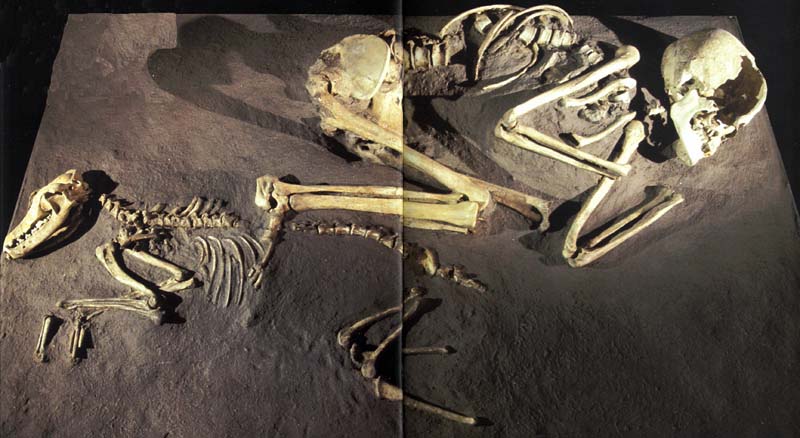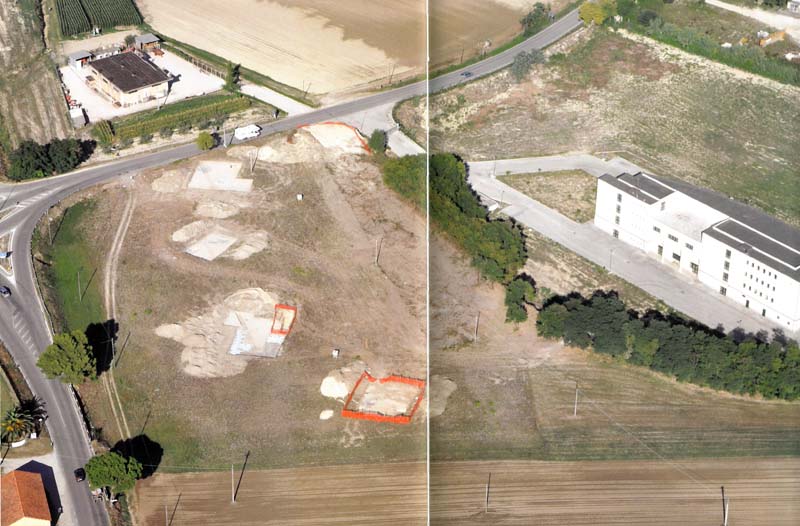The first real and small necropolises organized within the villages at the center of the large inhabited area date back to the cultures of Ripoli and Serra d'Alto.
Burials are one of the most peculiar aspects of Neolithic history. Early Neolithic funerary ritual is characterized by simple pits”… deposition on the left side, absence of equipment, rare presence of millstones or cereals. Always in oval or circular pits dug into the earth or rock, sometimes bordered by stones …” (from Giuliano Cremonesi, 1965).
In 1914 it was excavated "… a strip of black earth about eighty meters long and about eight meters wide …”, probably in the center of the site, in a North East – South West direction. Within this strip numerous burials were found in pits defined by Messina as "… huts – sepulcher …”, perhaps believing that the buried had been placed on the bottom of huts, a hypothesis accepted for some of them also by Rellini. “… According to what Rellini (1934) reports, some pits contained several skeletons and in one there was the woman with the dog, for which the most immediate comparison is with the analogous Chiozza burial of the Vasi a Bocca Quadrata culture (De Buoi , 1940) …” (from Renata Grifoni Cremonesi, 2009).
In 1971 the burial from the Superintendency of Ancona (to whose jurisdiction Abruzzo belonged at the time) was taken to the Archaeological Museum of Chieti, restored and exhibited to the public. Today it is located in the Archaeological Museum of Teramo. At the foot of the skeleton of an adult woman, who lies on her left side as in almost all Neolithic burials, is the skeleton of a dog in an almost parallel position but upside down with respect to the woman. A singular reality, to which however no interpretation or meaning has been given. Perhaps also because in relation to all the numerous burials in Ripoli only general considerations have been formulated. Only the Grifoni Cremonesi ventures a hypothesis on the presence of a dog as a sign "… of social distinction in the Late Neolithic …” in the text entitled “Caves, pits, stone circles, vegetable and animal offerings, waters and symbols: evidence of cults and rites in Italian prehistory”.
The data on the burials of Ripoli are rather uncertain”... since the Messina excavation in 1914 consisted in opening long trenches but the materials were not kept separate and it is therefore not possible to reconstruct the associations of any grave goods and the reciprocal relationships between the burials, nor to establish at which stages of the culture of Ripoli they belonged…".
"… This lack of documentation in the central area of the Peninsula, which contrasts with the good number of known habitation sites and with the quantity of burials known throughout the Neolithic period, could suggest a type of funerary ritual that left few traces, but at this point we are dealing with mere hypotheses ... We must also consider that towards the end of the period, in a moment of transition to the Copper Age, monumental structures and areas used for cults appear, therefore evidence of a great importance, attributed to the funerary ritual that arise on previous Neolithic installations by expanding and modifying the older structures …” (from Renata Grifoni Cremonesi, 2009). That great importance attributed to funerary ritual in the Neolithic seems to express the feeling of a continuity of experience between life and death, with a respectful and unemphatic form, a simple return to the earth, a continuity of experience between life and death, so as to bury the dead in the center of the town.


Historical notes
For the historical notes see report "The Culture of Ripoli"
CARD
LATEST PUBLISHED TEXTS
VISIT THE FACTSHEETS BY OBJECT

